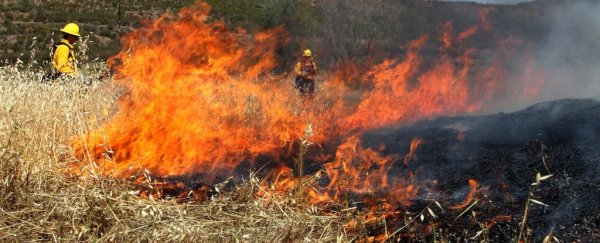A new gel-like fluid that sticks to vegetation for months on end could be an ingenious new way to stop mother nature from burning.
Devised by an engineer and a former fire-prevention forester, this sprayable retardant could one day be used to drastically reduce the number of forest fires experienced each year.
By coating vast areas of vegetation in particularly susceptible areas, it's hoped that this technique could act like a vaccine against future fire outbreaks.
"This has the potential to make wildland firefighting much more proactive, rather than reactive," says materials scientist and engineer Eric Appel from Stanford University.
"What we do now is monitor wildfire-prone areas and wait with bated breath for fires to start, then rush to put them out."
Today, when firefighters respond at the site of active fires, they use retardants such as inorganic salt ammonium polyphosphate, or APP, which creates water when it's burned.
The problem is, these solutions only work in the short-term, because they lose their effectiveness once the water they hold evaporates. And in most wildfires, that can happen in under an hour.
The new gel is essentially a sticky and fire-resilient carrier for these chemical retardants. Made primarily from plant material, the material is cellulose-based, which means it clasps to vegetation throughout rain, wind, or shine.
What's more, the inventors say it's also non-toxic and can be safely sprayed onto the environment using current agricultural equipment or aircraft.
So far, it's been tested on grass and chamise by the California Department of Forestry and Fire Protection (CalFire), and in both scenarios the spray provided complete fire protection, even after heavy rainfall. In comparison, other commercial retardants provided little or no protection.
"We don't have a tool that's comparable to this," says Alan Peters, a CalFire division chief who monitored some of the test burns.
"It has the potential to definitely reduce the number of fires."
Not only can this stuff be used to prevent fires, in much larger doses it can also be used to stop a fire once it's started - in the same way that fire retardants are currently sprayed on fires.
Wildfires around the world are only expected to become more intense and frequent as climate change worsens, and currently our methods for management are quite limited.
New inventions and techniques are desperately needed in these unprecedented times, and researchers are now working with the state of California to test this gel in tree-lined roadside areas, which spark dozens of fires in the region every year. If it works, it could protect countless lives and livelihoods in many more places.
The findings are reported in PNAS.
